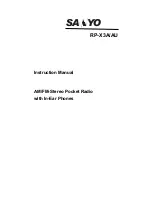
1 - 6
CA10 User Guide
Subnet Mask.
A 32-bit number used to separate the network and host sections of an IP address. A custom subnet
mask subdivides an IP network into smaller subsections. The mask is a binary pattern that is matched up with
the IP address to turn part of the host ID address field into a field for subnets. Default is often 255.255.255.0.
T
TCP/IP.
(Transmission Control Protocol/Internet Protocol) A communications protocol used to internetwork
dissimilar systems. This standard is the protocol of the Internet and has become the global standard for
communications. TCP provides transport functions, which ensures that the total amount of bytes sent is
received correctly at the other end. UDP is an alternate transport that does not guarantee delivery. It is widely
used for real-time voice and video transmissions where erroneous packets are not retransmitted. IP provides
the routing mechanism. TCP/IP is a routable protocol, which means that all messages contain not only the
address of the destination station, but the address of a destination network. This allows TCP/IP messages to be
sent to multiple networks within an organization or around the world, hence its use in the worldwide Internet.
Every client and server in a TCP/IP network requires an IP address, which is either permanently assigned or
dynamically assigned at startup.
Telnet.
A terminal emulation protocol commonly used on the Internet and TCP/IP-based networks. It allows a user
at a terminal or computer to log onto a remote device and run a program.
Terminal.
See
Mobile Computer
.
TKIP.
Temporal Key Integrity Protocol (TKIP) uses the same as WEP for encryption with advanced key
management and effective message integrity checking.
TFTP.
(Trivial File Transfer Protocol) A version of the TCP/IP FTP (File Transfer Protocol) protocol that has no
directory or password capability. It is the protocol used for upgrading firmware, downloading software and
remote booting of diskless devices.
W
WEP40.
Wired Equivalent Privacy encryption based on 64-bit key string.
WEP128.
Wired Equivalent Privacy encryption based on 128-bit key string of 26 hexadecimal (base 16) characters
(0-9 and A-F).
WPA.
Wi-Fi Protected Access is security protocol for wireless 802.11 networks from the Wi-Fi Alliance.
Summary of Contents for CA10
Page 1: ...CA10 User Guide ...
Page 2: ...CA10 User Guide 72E 124942 01 Revision A August 2009 ...
Page 5: ...iv CA10 User Guide ...
Page 11: ...x CA10 User Guide ...




































